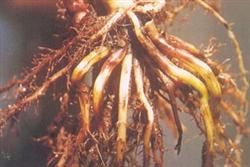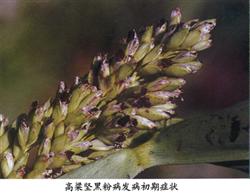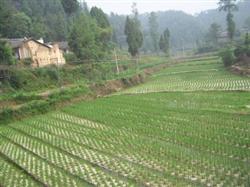Sorghum black onion mold root rot

Symptoms can occur in both seedling stage and adult stage. In the seedling stage, the disease appeared like water-deficient wilting, the cortex and vascular bundles of the diseased seedlings showed brown water stains, and the fine roots softened and rotted. The infected leaves of adult plants drooped slightly, the old leaves yellowed, and began to dry up from the tip and edge of the leaves. The diseased root and the root crown become brown and rotten. The pathogen Periconia circinata (Mangin) Sacc. It is called sorghum black onion flower mold, which belongs to the subphylum of semiknowns. Conidiophores erect, 2 Mel 3 fascicles or solitary, brown to dark brown, wall thick, 1 50 × 6 Mel 8 (um), near apical rotation, apical cells dilated, above 3 sporogenic cells, apical cells can divide, each division, forming a sporogenic cell, on which conidia are in series. The conidia are dense into capitate, black, globose, smooth or spiny surface, 12-27um in diameter. The pathways of transmission and disease conditions this bacteria is saprophytic bacteria, can induce the plant aboveground or root disease. Prevention and control methods (1) crop rotation has been carried out for more than 3 years. (2) strengthen management, appropriate density, use high ridge or high border cultivation, do not plant sorghum in low-lying land. (3) the compost made by fully mature organic fertilizer or Japanese enzyme bacteria should be drained in time after rain, and flood irrigation is strictly prohibited.
- Prev

Rational fertilization in Sorghum cultivation
What kinds of smut are there in sorghum? Scattered smut, hard smut and head smut are common in North China. (1) Sorghum loose smut: whole ear or part of grain is damaged. Before the diseased grain breaks, there is a gray-white film, which spreads out black powder (bacteria) after the film is broken, exposing a long and curved axis, which is sorghum scattered ear.
- Next

Soil requirements of Sorghum
Rice red blight, which is called "red blight" of rice, is a common physiological disease in rice production. The yield of rice after sitting has a great impact, generally resulting in a yield reduction of 10% to 20%, and a serious yield reduction of more than 50%. According to the survey, the perennial area of our district is about 40,000 mu, accounting for about 10% of the rice planting area. This year, 4.
Related
- The first cup of black tea in spring, the flavor and history of tea gardens in Kenya, Africa
- The computer can not only choose potatoes, but also grow tea rice. AI will grow winter oolong tea champion.
- It is not only the inflated tea bitten by insects, but also engraved with the four seasons tea in Beipu.
- The Oriental Beauty Tea Festival in Zhuxian County takes the stage at the weekend to experience the plus-size feast of oil tea.
- & quot; Oriental Beauty Tea & Exploration of Emei in Hsinchu, the hometown of quot;
- The new variety of strawberry "Tainong 1" dessert is the first choice with mellow aroma. Crimson gorgeous
- History of Tea in Taiwan: from Wild Inner Mountain to Export Tea Garden
- Two types of Taiwan Oriental Beauty Black Tea won the British three-Star Award for Childhood Tea Xiang Zhang Jiaqi changed from pilot to champion tea maker.
- Banana species and varieties: the planting history of Taiwan Xianren banana and dwarf banana is long, is banana disease resistant?
- Coffee planting Technology: Qianjie Coffee from Seedling to harvesting

